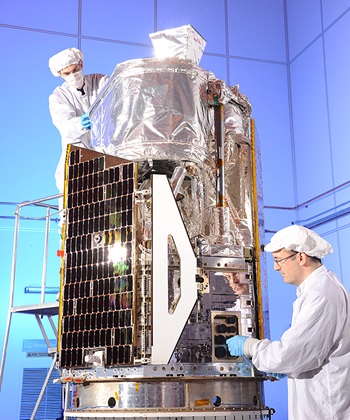Building for the Next Exploration of Our Galaxy

 The NuStar satellite in the Satellite Manufacturing Facility.
The NuStar satellite in the Satellite Manufacturing Facility.Northrop Grumman is a critical NASA partner on programs that are helping humankind make discoveries about our universe. The agency recently took another step in unlocking the next advancement in mapping our galaxy by reaching a Key Decision Point C (KDP-C) on the Compton Spectrometer and Imager (COSI) Project.
COSI’s gamma ray instrument is expected to map remnants of supernova explosions to help us learn about the final stages of the lives of stars and the formation of chemical elements in the Milky Way. This work is led by the Principal Investigator Dr. John Tomsick and the COSI Project Office at the University of California, Berkeley’s (UCB) Space Sciences Laboratory (SSL). Northrop Grumman is building the satellite for the mission, performing observatory integration and test and launch operations.
The KDP-C is a major milestone for the program that was first awarded by NASA in 2020, giving us the greenlight to start building the satellite, which will be based on our LEOStar-2 satellite bus.
“With this decision, NASA approves the mission to move forward from the development phase into implementation. This new phase will include detailed design, fabrication, integration and test, and launch and primary mission,” said Anjali Mehra, Northrop Grumman program manager for COSI.
Northrop Grumman has been a major spacecraft provider for NASA’s oldest continuous program – the Explorers program – which started in 1958 and supports the agency’s astrophysics, heliophysics and Earth science research. We have built eight of the last 13 launched spacecraft for the program, and since 2000 we have built or are selected to build 16 satellites for Explorers missions.
Our flight-proven satellite busses, rigorous engineering processes and end-to-end mission capabilities enable us to deliver science missions that enable new discoveries. This work is furthering human knowledge of our Earth, solar system and the universe beyond.
“COSI continues our long-standing relationship with UC-Berkeley’s Space Sciences Lab, including on the Ionospheric Connection Explorer (ICON) and Nuclear Spectroscopic Telescope Array (NuSTAR) Explorers missions,” said Mehra. “When seeking a spacecraft partner for COSI, the PI chose to team with us on a sole-source basis.”
COSI joins two other Explorer programs currently in Northrop Grumman’s portfolio. In 2022, NASA selected us to build Helioswarm, a constellation of nine spacecraft that will capture the first in-space measurements of solar wind turbulence. The spacecraft will be based on Northrop Grumman’s ESPAStar and LEOStar-2 satellite buses that can accommodate separate payloads in orbit.
And earlier this year, Northrop Grumman was selected to provide the spacecraft and instrument mechanical subsystem, and complete observatory integration and testing for UVEX (UltraViolet EXplorer), which will be based on our LEOStar-2 satellite bus. The UVEX telescope will conduct a highly sensitive all-sky ultraviolet survey to study stellar explosions and massive stars, which will enable scientists to better understand dynamic events in our changing universe. The mission will also be managed by UCB/SSL, building on Northrop Grumman’s partnership with the laboratory.
“We are sought out as a spacecraft provider based on our extensive flight heritage, respect for scientific goals and objectives and experience working with a multitude of PIs and managing institutions,” said Mehra.
The COSI KDP-C is our most recent milestone in a long history of our contributions to NASA’s Explorers missions. Our flight-proven satellite busses, rigorous engineering processes and end-to-end mission capabilities enable us to deliver science missions that continue to produce new discoveries about our universe. Much more to come as we continue to support NASA and work with our partners to deliver reliable spacecraft for these groundbreaking missions.